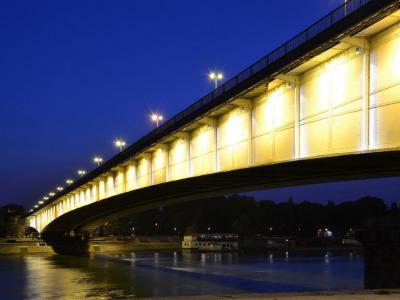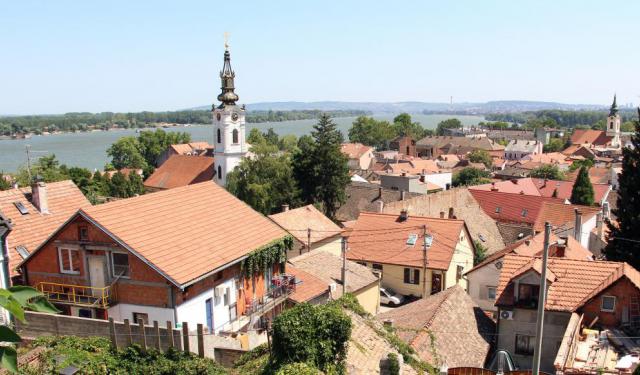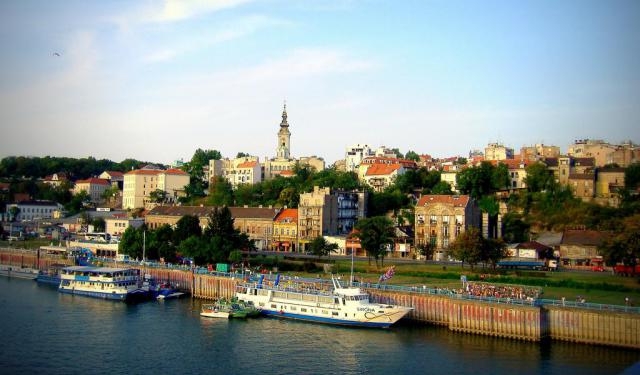Branko's Bridge, Belgrade
Branko's Bridge in Belgrade spans the Sava River and connects the city center with New Belgrade. It is the second-largest bridge in Belgrade, after the Gazela Bridge. The current bridge was constructed in 1956, utilizing the foundations of the 1934 King Alexander Bridge, which was destroyed during World War II. This reconstruction re-established a vital link between Belgrade and Zemun, being the only motorway bridge at the time.
Originally named the King Alexander Bridge, the predecessor of Branko's Bridge was a chain-stayed structure opened on December 16, 1934. This bridge was demolished in 1941 during the war. The new bridge, built in 1956, retained the lower parts of the original pylons, which were decorated by Ivan Meštrović in Serbo-Byzantine style. These pylons now serve as constraints for the bridge's two secondary spans.
Branko's Bridge is a continuous steel box girder bridge, measuring 450 meters (1,480 feet) in length. It features a central span of 261 meters (856 feet) and side spans of 81 meters (266 feet) each. The bridge has a dual carriageway with three lanes in each direction, consisting of two separate constructions completed in 1956 and 1979, respectively.
The name Branko's Bridge is commonly associated with Branko Radičević, a Serbian romanticist poet. An urban myth suggests the name also relates to Branko Ćopić, a writer who committed suicide by jumping from the bridge in 1984.
Branko's Bridge is not only a crucial infrastructural element in Belgrade but also a structure rich in historical and cultural significance. Its evolution from the King Alexander Bridge, through various phases of naming and reconstruction, reflects the turbulent history and the enduring resilience of the city.
Originally named the King Alexander Bridge, the predecessor of Branko's Bridge was a chain-stayed structure opened on December 16, 1934. This bridge was demolished in 1941 during the war. The new bridge, built in 1956, retained the lower parts of the original pylons, which were decorated by Ivan Meštrović in Serbo-Byzantine style. These pylons now serve as constraints for the bridge's two secondary spans.
Branko's Bridge is a continuous steel box girder bridge, measuring 450 meters (1,480 feet) in length. It features a central span of 261 meters (856 feet) and side spans of 81 meters (266 feet) each. The bridge has a dual carriageway with three lanes in each direction, consisting of two separate constructions completed in 1956 and 1979, respectively.
The name Branko's Bridge is commonly associated with Branko Radičević, a Serbian romanticist poet. An urban myth suggests the name also relates to Branko Ćopić, a writer who committed suicide by jumping from the bridge in 1984.
Branko's Bridge is not only a crucial infrastructural element in Belgrade but also a structure rich in historical and cultural significance. Its evolution from the King Alexander Bridge, through various phases of naming and reconstruction, reflects the turbulent history and the enduring resilience of the city.
Want to visit this sight? Check out these Self-Guided Walking Tours in Belgrade. Alternatively, you can download the mobile app "GPSmyCity: Walks in 1K+ Cities" from Apple App Store or Google Play Store. The app turns your mobile device to a personal tour guide and it works offline, so no data plan is needed when traveling abroad.
Branko's Bridge on Map
Sight Name: Branko's Bridge
Sight Location: Belgrade, Serbia (See walking tours in Belgrade)
Sight Type: Attraction/Landmark
Sight Location: Belgrade, Serbia (See walking tours in Belgrade)
Sight Type: Attraction/Landmark
Walking Tours in Belgrade, Serbia
Create Your Own Walk in Belgrade
Creating your own self-guided walk in Belgrade is easy and fun. Choose the city attractions that you want to see and a walk route map will be created just for you. You can even set your hotel as the start point of the walk.
Belgrade Old Town (Zemun) Walking Tour
Belgrade's Old Town, also known as Zemun, spread around Gardos Hill, is one of the city's oldest parts. Throughout the centuries, as the Balkans were part first of the Roman, then the Byzantine, and then the Austro-Hungarian empires, this area transformed into a beautiful neighborhood with narrow streets, cute buildings, and breathtaking views opening from the hill onto the Old Town and... view more
Tour Duration: 2 Hour(s)
Travel Distance: 2.4 Km or 1.5 Miles
Tour Duration: 2 Hour(s)
Travel Distance: 2.4 Km or 1.5 Miles
Kalemegdan Park and Belgrade Fortress Walking Tour
The most beautiful park in Belgrade, Kalemegdan Park, or simply Kalemegdan, is also the largest park and the most important cultural and historical complex in the city. The actual park occupies a smaller portion, in the southern corner, of another, grander monument – the Belgrade Fortress (which is some two millennia older).
The fortress itself, often erroneously referred to, even by the... view more
Tour Duration: 2 Hour(s)
Travel Distance: 2.1 Km or 1.3 Miles
The fortress itself, often erroneously referred to, even by the... view more
Tour Duration: 2 Hour(s)
Travel Distance: 2.1 Km or 1.3 Miles
Belgrade Introduction Walking Tour
Belgrade has been a city of strategic importance for millennia with its location at the confluence of the Sava and Danube rivers. In fact, it is one of the oldest continually inhabited cities on the planet.
Nomadic tribes inhabited the area as far back as 20,000 to 50,000 years ago. Some of these may have been Neanderthals rather than modern humans. By the sixth century BC, the Vinca culture... view more
Tour Duration: 2 Hour(s)
Travel Distance: 4.0 Km or 2.5 Miles
Nomadic tribes inhabited the area as far back as 20,000 to 50,000 years ago. Some of these may have been Neanderthals rather than modern humans. By the sixth century BC, the Vinca culture... view more
Tour Duration: 2 Hour(s)
Travel Distance: 4.0 Km or 2.5 Miles






